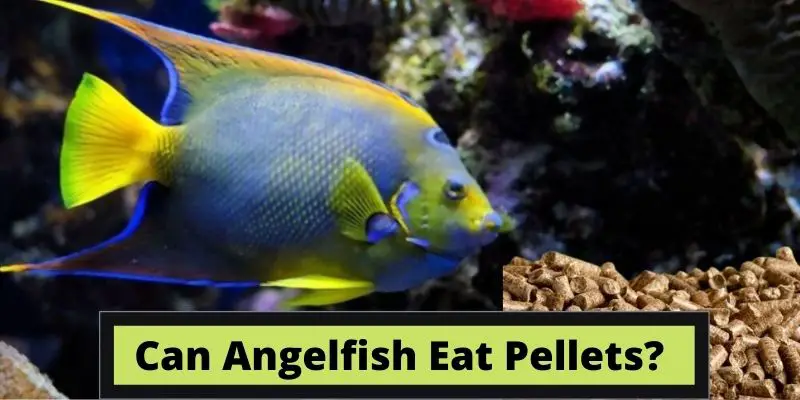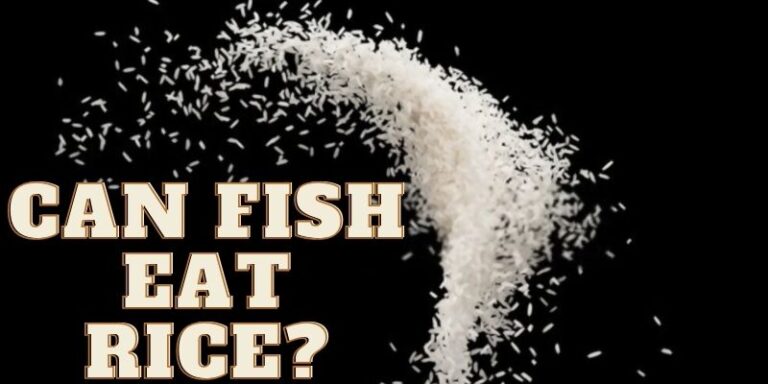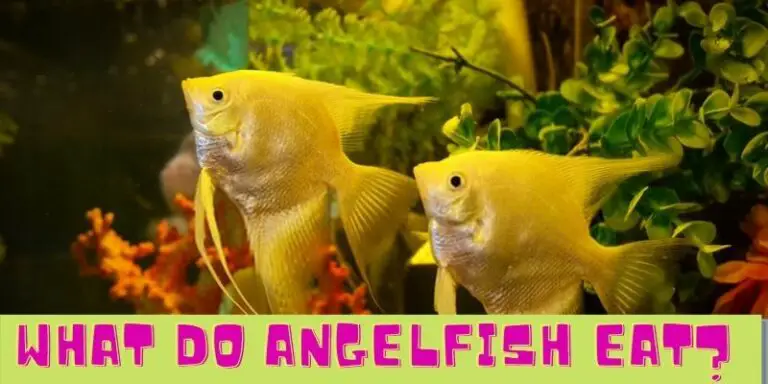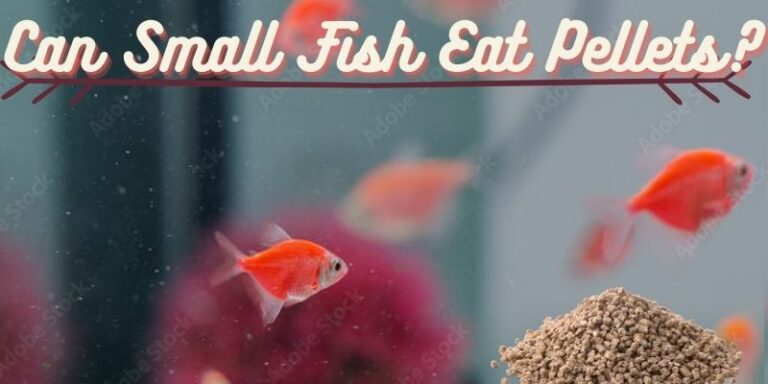Can Angelfish Eat Pellets? [Dangerous or Safe?]
Angelfish eat foods such as insects, small fishes, sponges, brine shrimp, black worms, white worms, and crustaceans. But many people had the question, can angelfish eat pellets?
Angelfish can eat pellets, and they love eating pellets. Pellets are full of nutrition and protein, improving their immunity and giving them good growth. Also, the pellets are in a simple form, so it will be easy for angelfish to digest them.
Do Angelfish Like Pellets?
Yes, they like eating pellets as they are easy to swallow and digest. Angelfish can eat pellets since they are omnivores, meaning they eat both plant and animal stuff.

A high-quality pellet meal will give your angelfish the nutrition they need for proper growth and development.
Though, to bring diversity to their diet, you can also add live or frozen food, as well as fresh fruits and vegetables, to their diet. You can give them pellet meals instead of other fish food, although they thrive on both.
To buy pellets, you need to go to some pet store or can order online. Make sure to feed your angelfish in moderate quantities, not in large amounts or much less.
So, ensure that you provide sufficient food in the tank for your fish by keeping in mind during feeding them pellets that they are not hungry for their next meal
Nutrition In Pellets For Angelfish?
Pellets are an excellent food for angelfish to eat. They are not only nutritious for your pet fish but also quite simple on their digestive system and do not create swim bladder difficulties when soaked.
Moreover, Pellets are not the only source of high-quality protein, but they are also used as a diverse range of protein sources.
This allows you to supply a diversified diet for your fish without having to purchase ten different foods.
Do Angelfish Prefer Flakes or Pellets?
They enjoy eating both flakes and pellets. Your angelfish will prefer to eat fresh, freeze-dried, frozen flake food. Since they are surface feeders, so it is easy for them to eat flakes than pellets.
So, if pellets and flakes are offered to angelfish at a time, they will prefer flakes as the pellet remains at the bottom while flakes stay on the surface. So due to surface feeder nature, they will rush towards flakes more than pellets.
How To Feed Angelfish Pellets?
It is simple to feed pellets to your angelfish. To feed them pellets, put them directly into the tank.
Instead, you can feed them using any object to hold the pellet and then place it in the water tank. There’s no need to be concerned; follow the steps outlined below for each.
- Direct feeding them pellets is the simplest method of feeding angelfish. Put a few little pellets in the tank and allow your fish to eat them.
- You can also feed your fish with the help of tongs, fingers, forks, or any other object you wish. You can either give one pellet at a time or many pellets in one go.
- You can also use food-sinking tablets. These are little tablets that are useful to hold the pellets trapped in a gel that dissolves after putting them in the water. It will then build a thin layer on top of the water surface that will attract angelfish to eat the pellets.
How Often & How Much To Feed Angelfish Pellets?
Angelfish can be fed with pellets daily, and it will support them in growing faster, healthier, and having a better time.
Your task is to ensure that you are serving your angelfish pellets with water from a pitcher or bowl rather than directly from the fish tank.
Feeding the angelfish directly from the tank can cause overeating by angelfish, which can lead to severe health issues.
So, make sure to follow all the precautionary steps before feeding them pellets to overcome the chance of any mishap.
Moreover, remove any uneaten food after a few minutes to avoid affecting your fish’s health and life expectancy.
The amount of food you give your angelfish is figured out by several factors, including the fish’s size and surroundings.
You will have to keep an eye on your fish’s eating patterns and actions. There will be a phase of experimenting before you find out exactly how much to feed your fish.
Feeding amounts will also need to be adjusted as your fish grows. You can feed your angelfish more pellets as they get older rather than live items.
Younger angelfish can eat 3 to 4 times each day generally. However, once they’ve reached full size, reduce the amount of food they’re given and stick to a regular feeding schedule.
If fed too much, angelfish will overeat and grow overweight. Also, feeding them too much will cause their stomach to burst, which is horrible for the surrounding.
They will die instantly after the stomach explodes, which will cause a mess in the tank, as well as your hands, will get dirty while cleaning the mess.
What Pellets Can Angelfish Eat?
Angelfish normally eat only small pellets. Also, Pellets offer a fantastic primary food source because they are very nutritionally dense, making them an excellent alternative for supplementing your fish’s diet.
Pellet food is a common fish meal, particularly for larger and farmed aquarium fish. The factory produces pellets of various sizes by the manufacturer by grounding up the feed components and then extruding them with heat and pressure.
Some are made to float in water, while others are made to sink. The types of pellets that angelfish can eat are discussed below.
Floating Pellets
These pellets float on the surface for far longer than other types of fish food. Because of the presence of a lot of air, they are called buoyant. For eating them, the fish will need to come up to the surface as they are floating on the surface of the water.
So, Top feeders such as angelfish get benefit from floating pellets. Also, Floating pellets provide a reasonable amount of protein and fat.
Sinking Pellets
Sinking pellets are high in nutrients that are highly beneficial to eat, and they are rich in protein and fat content, as well as a high-water absorption rate and water stability.
But the thing is, sinking pellets are ideal food for bottom feeders. Surface feeders only eat them when they go to the bottom in search of food when there is nothing left on the surface to eat.
So, these pellets settle at the bottom of the tank or pond and are consumed by bottom feeders.
Slow Sinking Pellets
Then there is one more type of pellet, which is slowly sinking. These are ideal meals for small angelfish.
These pellets come in many different sizes according to the size of your fish so that small babies of angelfish, do not get trouble eating them.
Can Angelfish Eat Cichlid Pellets?
Yes, they can eat cichlids pellets. Without a doubt, they are an important part of the goldfish diet.
Angelfish are omnivorous so they can eat anything from algae to flakes and cichlid pellets. However, avoid overfeeding your fish even if the food is highly nutritious, as an excess of everything is bad and harmful.
Too much food in their tank could cause these tiny fellas to choke or get too obese, posing a health risk to them.
Can Angelfish Eat Betta Pellets?
The quick answer is yes, Angelfish can eat betta pellets. However, do not feed them as angelfish regular diet.
Some of the nutrients that are the main requirement of many fish species are not included in it.
To provide the proper nourishment, Feed them that along with a variety of other items. Moreover, Betta pellets contain food coloring compounds, which can be toxic to the angelfish as they don’t have a liver that can help in breaking down this.
So, if angelfish eat them in big enough numbers over time, they can cause severe illness in them and maybe die due to these non-digested components.
Why Do My Angelfish Not Eat Pellets?
There could be many reasons for the question, why are your angelfish not eating pellets? One reason can be overfeeding them.
Angelfish are inquisitive eaters who rarely refuse food. However, if you feed them too much too frequently, they will naturally stop eating because they will not be hungry due to the last meal.
The general norm is to provide two to three meals every day. Secondly, angelfish are known to be tough fish, yet they are extremely sensitive to changes in water chemistry.
Angelfish can stop eating if the water chemistry, particularly the nitrate, nitrite, and ammonia levels, has changed.
Angelfish are not difficult species to care for, but if they stop eating, it might be difficult to determine what is wrong.
There could be several reasons, such as changes in water chemistry, overfeeding, or disease, which may assist aquarium owners in making changes that will make the angelfish healthier and happier.
- Check the water quality and, if necessary, make water changes. Observe the fish and look for signs of disease.
- Add Vitamins to water for fulfilling any deficiencies.
- Moreover, provide a diverse range of foods as fish can get bored by eating only one food and requires a different variety of feeds.
Final Thought
Angelfish can eat pellets whenever you serve them, they will enjoy eating them. Pellets are also beneficial for their health because they are nutritious food and full of protein, providing them with positive growth.
But excessive feeding should be avoided because it may lead to severe health conditions. Also, you need to feed them mixed foods instead of feeding them only specific food.






